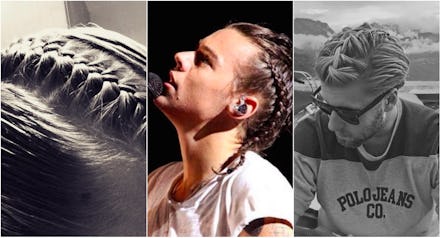The Thing We're Missing When Obsessing Over Men With Braids

Needless to say, hair trends come and go, and this year has seen more than we can keep track of (mermaid hair, anyone?). But the most remarkable have been the sheer number of men's hair looks, namely every ungodly combination of man bun and beard.
The latest getting social media tongues wagging? Men in braids. Specifically, ones that look like this:
Trend reports have hailed "manbraids" as the hottest new iteration of the man-bun style, with men being praised for "finally learning to do their hair." The assumption shot through the excitement: that men in braids is pretty much news to the general population.
Even though the style has been popular among men of color for decades, perhaps even longer.
That incongruity didn't go unnoticed by certain readers, who were quick to point out on social media that men wearing braids isn't a novelty. Take, for instance, Tumblr user Rosefant, who put it this way:
The appropriation problem: The problem with all the "trend" hullabaloo is that hair is a sensitive topic as well as a complicated one. Certain hairstyle "trends" aren't truly new trends, rather they are widely practiced techniques in certain communities of color.
But that often gets lost, especially when the origins of certain hairstyles aren't credited or don't come with enough context. That's when we start hearing cries of cultural appropriation, as Teen Vogue did this summer. Teen Vogue beauty and health director Elaine Welteroth documented her journey getting Senegalese twists in a photo essay online, but the version of the story in the magazine featured a fair-skinned model, prompting many on Twitter to slam the publication for excluding women of color and ignoring the hairstyle's origins.
Similar backlash arrived when Allure magazine published an article about an afro hairstyle with a white model. To the ire of readers, the headline, "You (Yes, You) Can Have an Afro" with the subhead "even if you have straight hair" seemed to address a presumptively white reader.
And the same thing happened when Marie Claire praised Kendall Jenner for taking hair "to a new epic level" with cornrows, neglecting to mention that black women and men have been wearing the style for years.
Men in braids? Yeah, not so new. Man buns twisted into French braids hasn't exactly been a signature style for people of color over the years, but the practice of men braiding their hair is most certainly not new.
Long, braided hair sometimes hold a symbolic meaning for certain Native Americans. In some cultures, wearing braided hair could carry a religious meaning or mean that the individual was preparing for battle.
In China, a hairstyle called the queue consisted of a long, thin braid worn on an otherwise shaved head. The queue goes back nearly 2,000 years, since the Han period, but gained particular political relevance later on. According to China scholar Michael R. Godley, in the seventeen century, "The conquering Manchus ordered the Chinese to follow northern customs once again and shave their heads except for a queue." By the 1890s, cutting the queue off amounted to a sign of rebellion.
Other tightly braided styles, like cornrows, have been popular among men of color, including African-American and Latino men for some time. Cornrows pull the hair into a taut style that makes it easier to manage on a day-to-day-basis. It requires little maintenance and can be left in for weeks at a time, and the designs vary from straight rows to intricate designs.
Within cornrows there are even more specific traditions, including ones that hail from beyond U.S. borders.
"In Trinidad, we call them 'cane rows,' because of slaves planting sugar cane," Patrice Grell Yursik, the blogger behind AfroBella, told Refinery29, the hairstyle literally built into many peoples' personal histories and heritages.
Stateside, they've long been associated with hip-hop artists, not to mention basketball players like Allen Iverson.
Hairstyles aren't limited to any one person, and different cultures and communities can inspire endless new iterations. Sheer inspiration, though, doesn't occur in a vacuum; it's important to acknowledge the history of a hairstyle.
In the meantime, maybe rethink the man bun altogether?